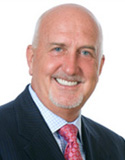
Dr. Thomas Dudney
For most dentists seating 8-10 porcelain veneers can quite often be a stressful appointment due to a variety of reasons. So naturally when I was asked to do a live patient demonstration at the Greater New York Dental meeting in front of 500 to 600 dentists in the audience I chose cementing ten porcelain veneers as my program. As if the thought of performing any dental procedure in front of such a 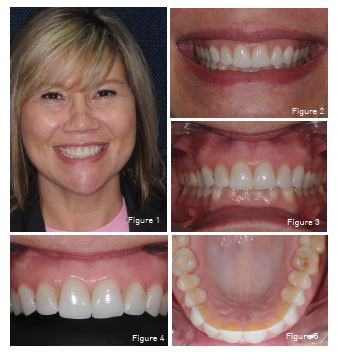 large group wasn’t stressful enough, I figured why not pick one where many things can and often do go wrong. Part of my reasoning was that the ”live portion” of the program, combined with a video showing tooth preparation and provisional fabrication, would allow me to demonstrate what we teach in the Pacific Aesthetic Continuum live patient hands-on programs, but also I felt confident that Gary Vaughn and his team at Corr Dental Designs would provide me with restorations that looked and fit great, making seating less stressful. Once the decision was made there was no going back and it was on to choosing the right patient that would further contribute to a smooth flowing procedure.
large group wasn’t stressful enough, I figured why not pick one where many things can and often do go wrong. Part of my reasoning was that the ”live portion” of the program, combined with a video showing tooth preparation and provisional fabrication, would allow me to demonstrate what we teach in the Pacific Aesthetic Continuum live patient hands-on programs, but also I felt confident that Gary Vaughn and his team at Corr Dental Designs would provide me with restorations that looked and fit great, making seating less stressful. Once the decision was made there was no going back and it was on to choosing the right patient that would further contribute to a smooth flowing procedure.
As it turned out the patient I selected was my hygienist because I knew it would be a minimal prep case and that I could count on her to have healthy tissue with no bleeding which would help to decrease some of the stress during seating. Temple had previously had eight porcelain veneers placed in our office that were now about 20 years old and while still clinically 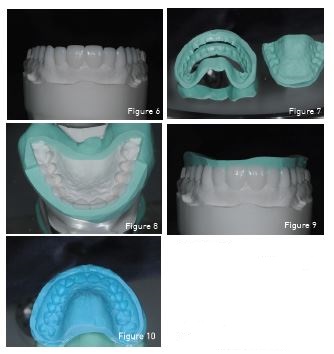 acceptable had begun to show signs of aging. Additionally I thought she could benefit from a little more length and restoring ten teeth instead of eight would increase width in the buccal corridors in order to provide support for facial soft tissues, decrease negative space, and give more fullness to the smile. It was also agreed upon that slightly whiter and brighter restorations would further enhance aesthetics and given the fact that Temple had been a loyal employee for over 20 years and would be a very cooperative and easy to work on patient, this program seemed to provide a good opportunity to redo her veneers with the type of case I desired. (Figure 1-5)
acceptable had begun to show signs of aging. Additionally I thought she could benefit from a little more length and restoring ten teeth instead of eight would increase width in the buccal corridors in order to provide support for facial soft tissues, decrease negative space, and give more fullness to the smile. It was also agreed upon that slightly whiter and brighter restorations would further enhance aesthetics and given the fact that Temple had been a loyal employee for over 20 years and would be a very cooperative and easy to work on patient, this program seemed to provide a good opportunity to redo her veneers with the type of case I desired. (Figure 1-5)
After case selection the first step was to determine incisal edge position and length of centrals and then forward all the necessary information to the laboratory with instructions for a diagnostic wax-up. The wax-up was used to fabricate prep guides to aid in tooth preparation and a putty matrix that would be used for a pre-op indirect mock-up as well as for making the provisional restorations. (Figure 6-10 ) At the post-op appointment provisional were utilized to evaluate the treatment goals including adding length, decreasing negative space, and a whiter, brighter smile, and also to serve as a blueprint for the laboratory to follow when fabricating the definitive restorations. (Figure 11-13)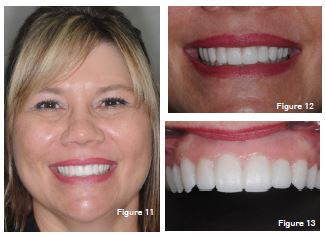
At the Greater New York Dental Meeting the actual try-in and cementation of the veneers in front of a live audience with multiple cameras from different angles projecting the procedure onto large screens was relatively stress-free. The cut back and layered Empress Veneers looked great and fit perfectly and along with the patient’s healthy tissue played a vital role in a successful outcome. The importance of the dental laboratory in smile design cases cannot be overstated. When combined with the principles and techniques taught in live patient hands-on programs like the Pacific Aesthetic Continuum (PAC), the laboratory contributes greatly to patient satisfaction and clinical success, not to mention appointments that are less stressful even when seating veneers in front of a large audience. To Gary Vaughn and all the people at Corr Dental Designs a big 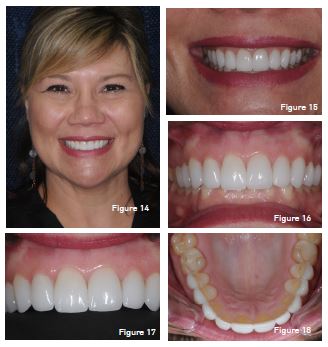 thank you for doing just that and a job well done. (Figure 14-18 )
thank you for doing just that and a job well done. (Figure 14-18 )
If you have questions about my article or if you would like to send a case, please contact the Pacific Aesthetic Laboratory Group at www.pacificaestheticdentalstudio.com, Gary Vaughn, CDT, CTO (916) 786-6740, or via email gvaughn@thePAC.org.
